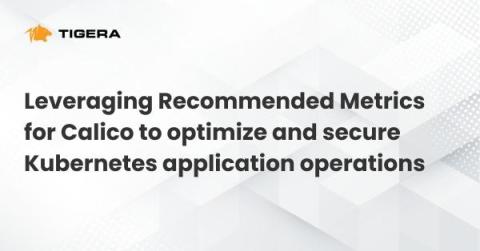Security | Threat Detection | Cyberattacks | DevSecOps | Compliance
Latest Posts
Integrating Calico Image Assurance (Vulnerability Management) with Azure DevOps Build Pipeline
What you can't do with Kubernetes network policies (unless you use Calico): The ability to log network security events
Leveraging Recommended Metrics for Calico to optimize and secure Kubernetes application operations
Troubleshooting DNS issues in Kubernetes: Investigate and reduce NXDOMAIN (domain does not exist) responses
Calico Egress Gateway: How to provide a stable public network identity for EKS workloads to securely connect with approved SaaS
Many organizations have adopted IP address allowlisting for their corporate cloud applications as an added layer of security. Many sanctioned cloud applications and web services enforce access restrictions based on the source IP address of incoming traffic. To establish a connection with these remote SaaS services, your traffic must originate from a particular IP address that is pre-registered. Any traffic originating from different IP addresses will be denied access by these remote applications.
Deploy multi-tenant Red Hat OpenShift clusters with Calico's namespace and workload isolation
As you are using OpenShift or are planning to use it for your containerized applications, ensuring robust security is crucial. As you dive deeper and your workloads become more complex, the need for advanced security measures becomes apparent. This is where Calico’s microsegmentation capability helps to achieve tenant and workload isolation. Let’s explore how Calico can be a game-changer in strengthening the security posture of your OpenShift environment.
Tigera Closes Out 2023 with Significant Momentum for Calico as Demand for Container Security Accelerates
As 2023 comes to a close, we’re happy to report that we’ve had a successful year full of powerful product advancements and notable third-party recognition.
Detect unknown network threats with Calico Cloud Honeypods
Based on the well-known cybersecurity method, “honeypots”, Calico Cloud runtime security approach of Honeypods as decoy pods are designed to attract traffic to them from malicious sources and to detect suspicious activity within a Kubernetes cluster.
Cisco Acquires Isovalent: A Big Win for Cloud-Native Network Security and a Validation of Tigera's Vision
This week’s news of Cisco’s intent to acquire Isovalent sends an important message to the cloud security ecosystem: network security is no longer an afterthought in the cloud-native world. It’s now a critical component of any robust security posture for cloud-native applications. This move not only validates the work of the Isovalent team in evangelizing this essential category but also underscores the vision Tigera has pioneered since 2016 with Project Calico.











